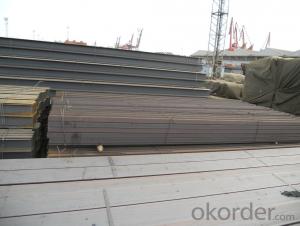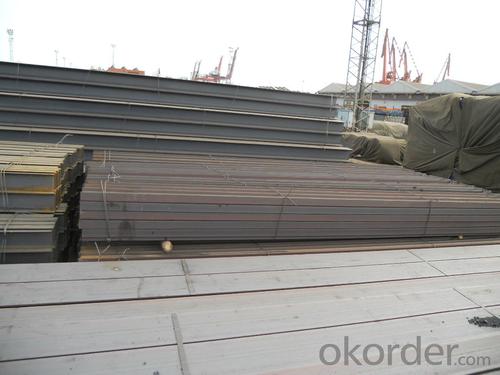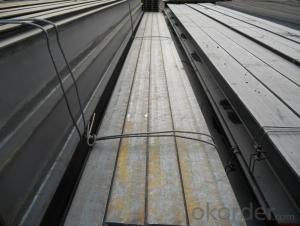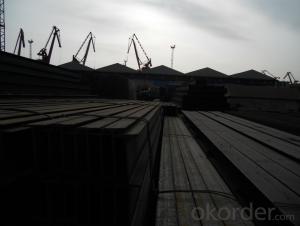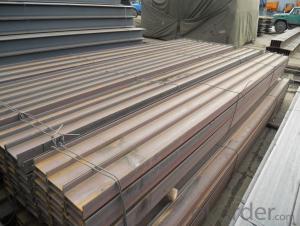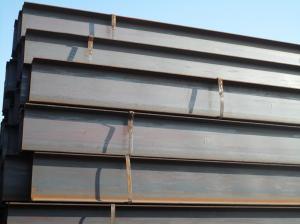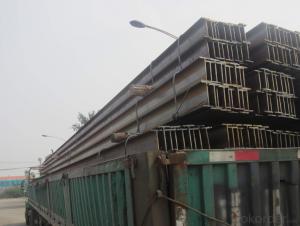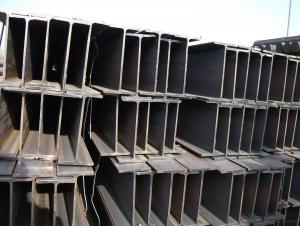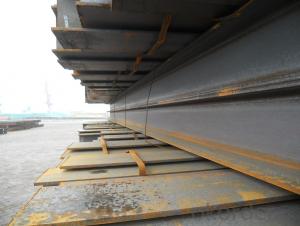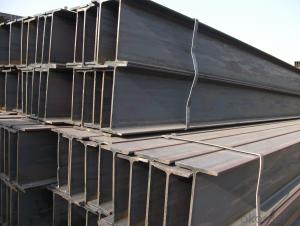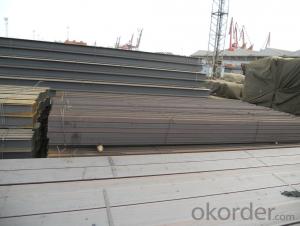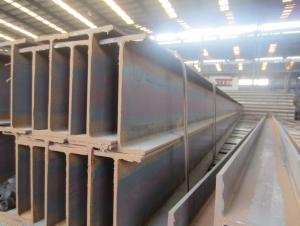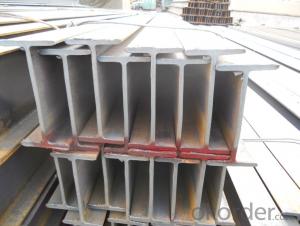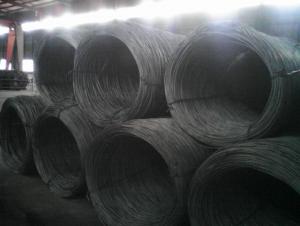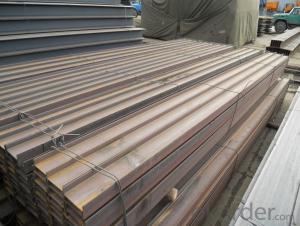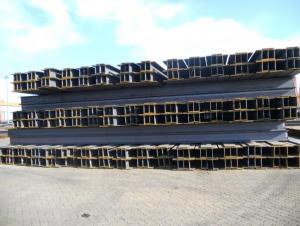JIS Standard Hot Rolled JIS Steel H-Beam
- Loading Port:
- China Main Port
- Payment Terms:
- TT or LC
- Min Order Qty:
- -
- Supply Capability:
- -
OKorder Service Pledge
OKorder Financial Service
You Might Also Like
Product Description:
OKorder is offering high quality Hot Rolled Steel I-Beams at great prices with worldwide shipping. Our supplier is a world-class manufacturer of steel, with our products utilized the world over. OKorder annually supplies products to European, North American and Asian markets. We provide quotations within 24 hours of receiving an inquiry and guarantee competitive prices.
Product Applications:
Commercial building structure ;Pre-engineered buildings; Machinery support structure; Prefabricated structure; Medium scale bridges; Ship-building structure. etc.
Product Advantages:
OKorder's Steel I-Beams are durable, strong, and resist corrosion.
Main Product Features:
· Premium quality
· Prompt delivery & seaworthy packing (30 days after receiving deposit)
· Corrosion resistance
· Can be recycled and reused
· Mill test certification
· Professional Service
· Competitive pricing
Product Specifications:
Manufacture: Hot rolled
Grade: Q195 – 235
Certificates: ISO, SGS, BV, CIQ
Length: 6m – 12m, as per customer request
Packaging: Export packing, nude packing, bundled
| H BEAM | ||||||
| size | h (MM) | b (MM) | t1 (MM) | t2 (MM) | Mass: Kg/m | LENGTH |
| 100x100 | 100 | 100 | 6.0 | 8 | 16.9 | 12M |
| 125x125 | 125 | 125 | 6.5 | 9 | 23.6 | 12M |
| 150x75 | 150 | 75 | 5.0 | 7 | 14.0 | 12M |
| 148x100 | 148 | 100 | 6.0 | 9 | 20.7 | 12M |
| 150x150 | 150 | 150 | 7.0 | 10 | 31.1 | 12M |
| 175x90 | 175 | 90 | 5.0 | 8 | 18.0 | 12M |
| 175x175 | 175 | 175 | 5.0 | 11 | 40.4 | 12M |
| 198x99 | 198 | 99 | 4.5 | 7 | 17.8 | 12M |
| 200x100 | 200 | 100 | 5.5 | 8 | 20.9 | 12M |
| 194x150 | 194 | 150 | 6.0 | 9 | 29.9 | 12M |
| 200x200 | 200 | 200 | 8.0 | 12 | 49.9 | 12M |
| 200x204 | 200 | 204 | 12.0 | 12 | 56.2 | 12M |
| 248x124 | 248 | 124 | 5.0 | 8 | 25.1 | 12M |
| 250x125 | 250 | 125 | 6.0 | 9 | 29.0 | 12M |
| 244x175 | 244 | 175 | 7.0 | 11 | 43.6 | 12M |
| 250x250 | 250 | 250 | 9.0 | 14 | 71.8 | 12M |
| 250x255 | 250 | 255 | 14.0 | 14 | 81.6 | 12M |
| 298x149 | 298 | 149 | 5.5 | 8 | 32.0 | 12M |
| 300x150 | 300 | 150 | 6.5 | 9 | 36.7 | 12M |
| 294x200 | 294 | 200 | 8.0 | 12 | 55.8 | 12M |
| 294x302 | 294 | 302 | 12.0 | 12 | 83.4 | 12M |
| 300x300 | 300 | 300 | 10.0 | 15 | 93.0 | 12M |
| 300x305 | 300 | 305 | 15.0 | 15 | 105.0 | 12M |
| 346x174 | 346 | 174 | 6.0 | 9 | 41.2 | 12M |
| 350x175 | 350 | 175 | 7.0 | 11 | 49.4 | 12M |
| 340x250 | 340 | 250 | 9.0 | 14 | 78.1 | 12M |
| 344x348 | 344 | 348 | 10.0 | 16 | 113.0 | 12M |
| 350x350 | 350 | 350 | 12.0 | 19 | 135.0 | 12M |
| 396x199 | 396 | 199 | 7.0 | 11 | 56.1 | 12M |
| 400x200 | 400 | 200 | 8.0 | 13 | 65.4 | 12M |
| 400x300 | 400 | 300 | 10.0 | 16 | 105 | 12M |
| 388x402 | 388 | 402 | 15.0 | 15 | 140 | 12M |
| 394x398 | 394 | 398 | 11.0 | 18 | 147 | 12M |
| 400x400 | 400 | 400 | 13.0 | 21 | 172 | 12M |
| 400x408 | 400 | 408 | 21.0 | 21 | 197 | 12M |
| 414x405 | 414 | 405 | 18 | 28 | 232 | 12M |
| 428x407 | 428 | 407 | 20 | 35 | 283 | 12M |
| 458x417 | 458 | 417 | 30 | 50 | 415 | 12M |
| 498x432 | 498 | 432 | 45 | 70 | 605 | 12M |
| 446x199 | 446 | 199 | 8 | 12 | 65.1 | 12M |
| 450x200 | 450 | 200 | 9 | 14 | 74.9 | 12M |
| 440x300 | 440 | 300 | 11 | 18 | 121 | 12M |
| 496x199 | 496 | 199 | 9 | 14 | 77.9 | 12M |
| 500x200 | 500 | 200 | 10 | 16 | 88.2 | 12M |
| 506x201 | 506 | 201 | 11 | 19 | 102 | 12M |
| 482x300 | 482 | 300 | 11 | 15 | 111 | 12M |
| 488x300 | 488 | 300 | 11 | 18 | 125 | 12M |
| 596x199 | 596 | 199 | 10 | 15 | 92.5 | 12M |
| 600x200 | 600 | 200 | 11 | 17 | 103 | 12M |
| 606x201 | 606 | 201 | 12 | 20 | 118 | 12M |
| 582x300 | 582 | 300 | 12 | 17 | 133 | 12M |
| 588x300 | 588 | 300 | 12 | 20 | 147 | 12M |
| 594x302 | 594 | 302 | 14 | 23 | 170 | 12M |
| 692x300 | 692 | 300 | 13 | 20 | 163 | 12M |
| 700x300 | 700 | 300 | 13 | 24 | 182 | 12M |
| 792x300 | 792 | 300 | 14 | 22 | 188 | 12M |
| 800x300 | 800 | 300 | 14 | 26 | 207 | 12M |
| 890x299 | 890 | 299 | 15 | 23 | 210 | 12M |
| 900x300 | 900 | 300 | 16 | 28 | 240 | 12M |
| 912x302 | 912 | 302 | 18 | 34 | 283 | 12M |
FAQ:
Q1: Why buy Materials & Equipment from OKorder.com?
A1: All products offered byOKorder.com are carefully selected from China's most reliable manufacturing enterprises. Through its ISO certifications, OKorder.com adheres to the highest standards and a commitment to supply chain safety and customer satisfaction.
Q2: Can stainless steel rust?
A2: Stainless does not "rust" as you think of regular steel rusting with a red oxide on the surface that flakes off. If you see red rust it is probably due to some iron particles that have contaminated the surface of the stainless steel and it is these iron particles that are rusting. Look at the source of the rusting and see if you can remove it from the surface.
Q3: How soon can we receive the product after purchase?
A3: Within three days of placing an order, we will begin production. The specific shipping date is dependent upon international and government factors, but is typically 7 to 10 workdays.
Images:
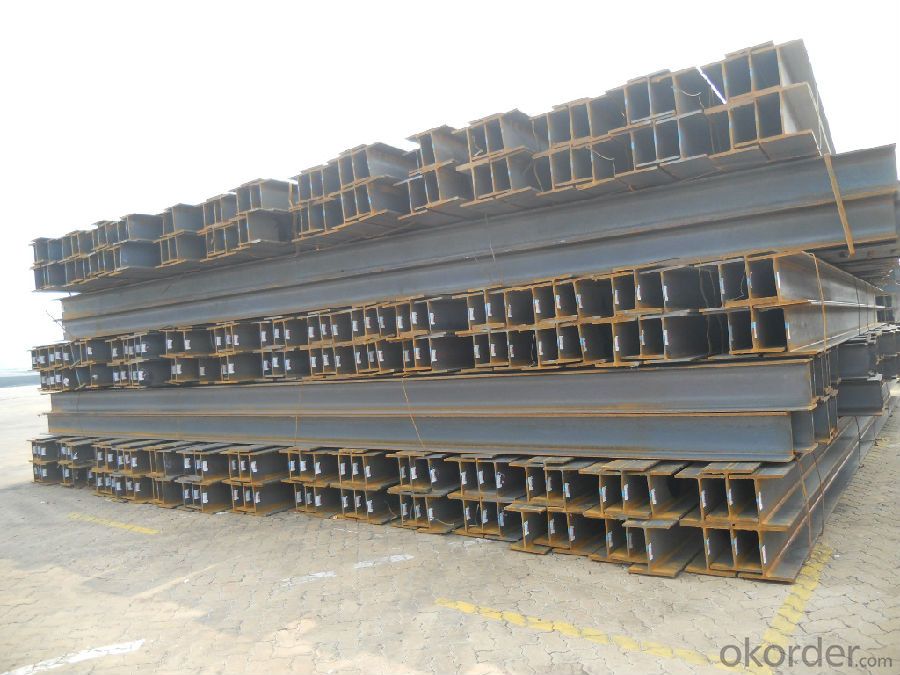
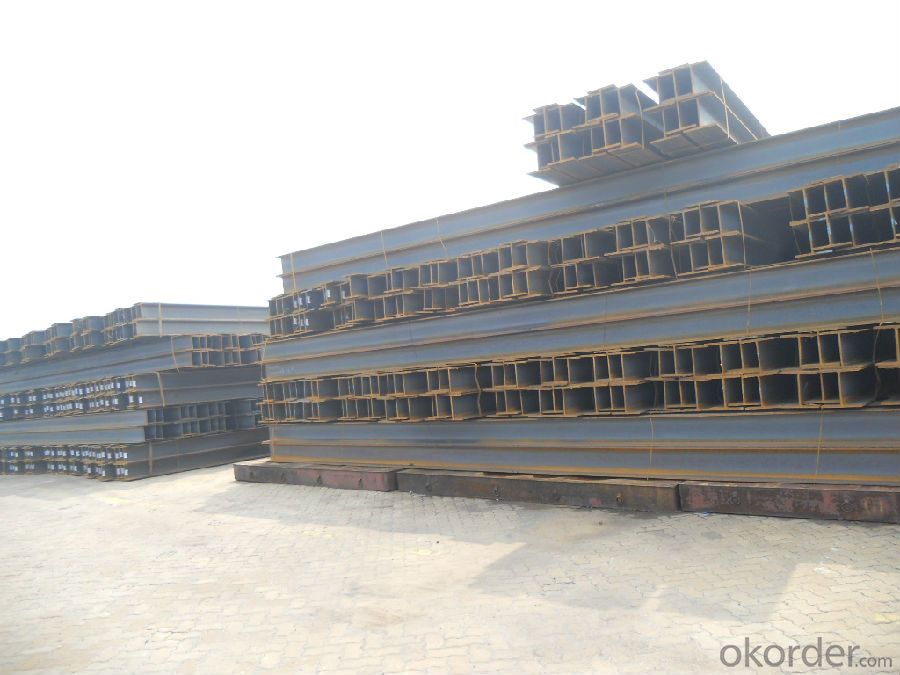
- Q: Can steel H-beams be used for supporting mining infrastructure?
- Steel H-beams prove to be a valuable solution for supporting mining infrastructure. Their strength and versatility make them a common choice in construction and civil engineering projects. These beams are specifically designed to withstand heavy loads and provide structural support, which makes them highly suitable for mining infrastructure. In the mining industry, the stability and safety of underground tunnels, shafts, and other mining structures are of utmost importance. This requires robust support systems. Steel H-beams are well-suited for this purpose as they possess a high load-bearing capacity and resistance to bending. These qualities enable them to endure the challenging conditions commonly found in mining environments. Moreover, steel H-beams offer customization options to cater to specific project requirements. They can be easily cut into various lengths and welded together to create larger structural elements. This enables the construction of complex support systems tailored to the unique needs of mining infrastructure. Furthermore, steel H-beams are known for their durability and long lifespan. This reduces the frequency of maintenance or replacement, which is significant in the mining industry. Minimizing downtime and maintenance costs is crucial to maintain productivity and profitability. In conclusion, steel H-beams are an excellent choice for supporting mining infrastructure due to their strength, versatility, and durability. Their ability to provide the necessary support and stability in mining environments makes them an ideal option for constructing and reinforcing underground mining structures.
- Q: What are the different joining techniques used for connecting steel H-beams?
- Some of the different joining techniques used for connecting steel H-beams include welding, bolting, and using adhesive bonding agents. Welding involves melting and fusing the steel beams together using heat, while bolting involves using bolts and nuts to fasten the beams together. Adhesive bonding agents, on the other hand, use specialized adhesives to bond the surfaces of the beams together. Each technique has its advantages and considerations depending on the specific application and requirements.
- Q: Can steel H-beams be used in the construction of mixed-use buildings or complexes?
- Yes, steel H-beams can be used in the construction of mixed-use buildings or complexes. Steel H-beams are commonly used in the construction industry due to their structural strength, durability, and versatility. They can support heavy loads and provide the necessary stability and rigidity for multi-story buildings. Additionally, steel H-beams allow for flexible design options, making them suitable for mixed-use buildings that incorporate various functions such as residential, commercial, retail, or office spaces.
- Q: Are steel H-beams resistant to impact and vibration?
- Steel H-beams have a high resistance to impact and vibration due to their H-shape design. This design provides stability and strength, making them suitable for withstanding various external forces, such as impacts and vibrations. The H-beams distribute the load evenly along their length, reducing stress concentration and preventing potential damage. Furthermore, steel is known for its durability and toughness, which enhances the H-beams' resistance to impact and vibration. As a result, steel H-beams are extensively used in industries like construction and engineering, where structural stability and resistance to external forces are vital.
- Q: What are the different design considerations when using steel H-beams in architectural projects?
- When using steel H-beams in architectural projects, there are several important design considerations to take into account. Firstly, the structural requirements of the project must be carefully assessed to determine the appropriate size and strength of the H-beams. This involves considering factors such as the loads the beams will need to support, the span they will cover, and any potential deflection limits. Another consideration is the aesthetic aspect of the design. Steel H-beams can be left exposed as a design feature in some architectural projects, so the appearance and finish of the beams should be considered. This may involve selecting a specific type of steel with desired aesthetics or exploring options for coatings or finishes. Fire resistance is also a crucial consideration. Steel H-beams can lose their strength in high temperatures, so fire protection measures need to be incorporated into the design. This may involve using fire-resistant coatings or incorporating fire-rated materials to protect the beams. Lastly, the fabrication and installation process should be considered. Steel H-beams are typically fabricated off-site and then transported to the construction site. Therefore, transportation and lifting requirements, as well as the ease of on-site assembly, must be taken into account during the design process. Overall, careful consideration of structural, aesthetic, fire resistance, and fabrication considerations is essential when using steel H-beams in architectural projects.
- Q: How do steel H-beams contribute to sustainable design?
- Steel H-beams contribute to sustainable design by providing structural strength and durability, allowing for the construction of long-lasting and resilient buildings. Their high load-bearing capacity enables the use of fewer materials, reducing resource consumption and minimizing waste. Moreover, steel H-beams are often made from recycled materials, reducing the demand for new raw materials and lowering carbon emissions. Additionally, their versatility and ease of installation make them suitable for various building types and designs, promoting flexibility and adaptability in sustainable construction practices.
- Q: What are the advantages of using steel H-beams?
- There are several advantages to using steel H-beams. First, they provide excellent structural support and load-bearing capacity, making them ideal for constructing large and heavy structures like bridges, buildings, and industrial facilities. Second, steel H-beams are highly durable and resistant to bending, warping, and corrosion, ensuring long-term stability and reliability. Additionally, they are versatile and can be easily fabricated and customized to meet specific project requirements. Finally, steel H-beams are cost-effective as they offer a high strength-to-weight ratio, reducing the amount of material needed for construction while still maintaining structural integrity.
- Q: Are steel H-beams easy to install?
- Yes, steel H-beams are relatively easy to install due to their standardized shape and size, allowing for straightforward alignment and connection. Additionally, their lightweight yet sturdy nature simplifies handling and positioning during installation.
- Q: How do Steel H-Beams contribute to the overall life cycle assessment of a structure?
- Steel H-beams contribute to the overall life cycle assessment of a structure in several ways. Firstly, these beams are commonly used as structural components in buildings, bridges, and other infrastructure projects due to their high strength and durability. The use of steel H-beams in construction helps to ensure the longevity and stability of the structure, which is a crucial aspect of the life cycle assessment. Additionally, steel H-beams have a high recyclability rate, meaning that they can be easily recovered and reused at the end of their life cycle. This promotes sustainability and reduces the environmental impact of the structure. Steel is one of the most recycled materials globally, and the use of H-beams contributes to the circular economy by minimizing waste and conserving natural resources. Moreover, the manufacturing process of steel H-beams has become more energy-efficient and environmentally friendly over the years. Advanced technologies, such as electric arc furnaces and energy recovery systems, are employed to reduce energy consumption and greenhouse gas emissions during production. This improvement in manufacturing practices positively impacts the life cycle assessment by reducing the embodied energy and carbon footprint of the structure. Furthermore, steel H-beams are known for their design flexibility and adaptability. They can be easily modified or replaced, allowing for future structural modifications or repurposing of the building. This adaptability extends the life cycle of the structure and reduces the need for complete demolition and reconstruction, which would have a significant environmental impact. In summary, steel H-beams contribute to the overall life cycle assessment of a structure by providing strength, durability, and stability. Their high recyclability, energy-efficient manufacturing, and design flexibility promote sustainability and reduce environmental impacts. By considering the use of steel H-beams in construction projects, we can enhance the overall performance and longevity of structures while minimizing their ecological footprint.
- Q: What are the different surface coatings available for steel H-beams?
- There are various surface coatings available for steel H-beams, including paint, galvanization, and powder coating. These coatings provide protection against corrosion, enhance the aesthetics, and improve durability of the steel beams.
Send your message to us
JIS Standard Hot Rolled JIS Steel H-Beam
- Loading Port:
- China Main Port
- Payment Terms:
- TT or LC
- Min Order Qty:
- -
- Supply Capability:
- -
OKorder Service Pledge
OKorder Financial Service
Similar products
Hot products
Hot Searches
Related keywords
